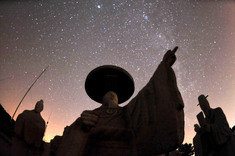After being washed out by the 2016 December supermoon, the Geminids will come roaring back in 2017. The famous and bright meteor shower will peak on overnight tonight (Dec. 13 and morning of Dec. 14). You can watch the Geminids live on Space.com here , beginning at 6 p.m. EST (2300 GMT), courtesy of NASA’s Marshall Space Flight Center in Huntsville, Alabama.
Update! Spectacular Geminid Meteor Shower Peaks Tonight! How to Watch Online
The Geminids are considered one of the best meteor showers every year because the individual meteors are bright, and the peak can see meteors stream across the sky at rates as high as 120 meteors an hour. Under light-polluted skies, fewer meteors will be visible. [December Lights: 6 Super Facts for the Geminid Meteor Shower ]
The Geminid meteor shower is nearly 200 years old, according to known records — the first recorded observation was in 1833 from a riverboat on the Mississippi River — and is still going strong. In fact, it’s growing stronger. That’s because Jupiter’s gravity has tugged the stream of particles from the shower’s source, the asteroid 3200 Phaethon, closer to Earth over the centuries.
The Geminids will shine brightly this year with almost no obscuring moonlight. The most meteors will appear in the hours after midnight, although you can see a good show earlier, too.
Credit: Gregg Dinderman/Sky & Telescope
When to see them
The meteors tend to peak about 2 a.m. local time, but can be seen as early as 9-10 p.m.
The Geminids, as their name implies, appear to emanate from the bright constellation Gemini (the twins). To find Gemini in the Northern Hemisphere, look in the southwestern sky for the constellation Orion, which is easy to spot by the three stars in the hunter’s “belt.” Then look just up and to the left of Orion to see Gemini, high in the southwestern sky. In the Southern Hemisphere, Gemini appears to the lower right of Orion and both will hang in the northwestern sky.
Although the meteors will appear to stream away from Gemini, they can appear all across the sky. For best results, you should look slightly away from Gemini so that you can see meteors with longer “tails” as they streak by; staring directly at Gemini will just show you meteors that don’t travel very far.
Where do they come from?
The Geminids are associated with the near-Earth object 3200 Phaethon , an asteroid that may have undergone a collision with another object in the distant past to produce the stream of particles that Earth runs into — creating the meteor shower.
The asteroid orbits the sun every 1.4 years. It occasionally comes close to Earth (at a safe distance) and also passes very close to the sun, inside of Mercury’s orbit and only 0.15 astronomical units from the sun. (An astronomical unit is the distance between the sun and the Earth: about 93 million miles or 150 million kilometers.)
Rocks in space that are about to collide with Earth’s atmosphere are called meteoroids. Those that streak through the atmosphere are called meteors, and if they reach the ground (which won’t happen with the Geminids, as the particles are too small to survive the trip) the rocks are called meteorites.
How to get the best view
Meteor showers don’t require binoculars or telescopes to view — just your bare eyes. Find a comfortable spot to lie on the ground, far away from lights and ideally in a dark-sky area. Bring a blanket and dress warmly if you’re in cold weather. Give your eyes about 20-30 minutes to adjust to the dark, then sit back and enjoy the show.
Editor’s note: If you capture an amazing view of the Geminid meteor shower or any other night sky view that you would like to share with Space.com for a possible story or gallery, send images and comments in to: spacephotos@space.com.

0 of 10 questions complete

Comments are closed.